2. How to Enjoy Pakistan Stamps
by
Takashi Kurosaki
(Last Revision: June 1, 2004)
Source: Takashi Kurosaki, "How to Enjoy Stamps of Pakistan," Paakisutaan (The journal of the Japan-Pakistan Association), No. 166, August 1999, pp.2-6.
Introduction
Pakistan celebrated the golden jubilee of independence in 1997. On 14 August 1947, a new state called Pakistan was born, when the Indian Subcontinent was divided into India and Pakistan. At that time, the areas belonged to Pakistan included West Punjab, the North West Frontier Province (NWFP), Sind, Baluchistan & Baluchistan States, Bahawalpur State, Khairpur State, East Bengal, and Sylhet. East Pakistan, created from East Bengal and Sylhet, formed an independent country Bangladesh in 1971 (more on Bangladesh Philately here).
Since the independence, a number of Pakistani stamps were issued. They vividly tell us about Pakistan and South Asia. In this essay, points to enjoy Pakistani philately are given.

1. The First Stamp of Pakistan
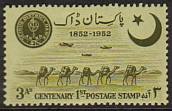
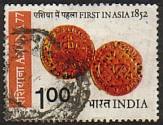 It is not so obvious which stamp is the first issue of Pakistan. The modern postal system in South Asia began in 1854 when the East India Company issued postage stamps. Before this issue, a local postage stamp was issued in 1852, known as "Scinde Dak". Scinde Dak is the oldest stamp in Asia and was used in Karachi City and remaining Sind regions. Since Karachi and Sind are part of Pakistan today, it is possible to claim that Scinde Dak is the first stamp of Pakistan. Unfortunately, I do not have this rarity stamp. Therefore, I show stamps of Pakistan (left) and India (right) depicting Scinde Dak.
It is not so obvious which stamp is the first issue of Pakistan. The modern postal system in South Asia began in 1854 when the East India Company issued postage stamps. Before this issue, a local postage stamp was issued in 1852, known as "Scinde Dak". Scinde Dak is the oldest stamp in Asia and was used in Karachi City and remaining Sind regions. Since Karachi and Sind are part of Pakistan today, it is possible to claim that Scinde Dak is the first stamp of Pakistan. Unfortunately, I do not have this rarity stamp. Therefore, I show stamps of Pakistan (left) and India (right) depicting Scinde Dak.
The East Indian issues of 1854 were used throughout the regions currently in Pakistan. However, since the notion of PAKISTAN did not exist at that period, it is theoretically difficult to call them (or Scinde Dak) the first stamp of Pakistan. The name PAKISTAN was invented around the 1930s to symbolize Muslim nations of the Indian Subcontinent: "P" from Punjab, "A" from Afghans (the majority of NWFP people), "K" from Kashmir, "S" from "Sind", and "TAN" from Baluchistan.
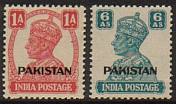
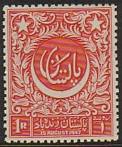 Therefore, the first stamp of Pakistan, according to the orthodox classification among philatelists, is a set of British Indian stamps overprinted "PAKISTAN" (see the photo on the left). Because of the turmoil due to the Partition of British India, the new state of Pakistan could not afford a commemorative stamp. One and a half months later, on 1 October 1947, new stamps of Pakistan were issued, which were British Indian stamps overprinted "PAKISTAN" by India's Printing Authority at Nasik. Pakistani people had to wait until July 1948 to have a set of new stamps printed for Pakistan. The photo on the right shows an 1 Re stamp from this set. This stamps is beautifully engraved with Urdu inscription reading "Long Live Pakistan." I would like to give to this issue the title of the first stamp of Pakistan.
Therefore, the first stamp of Pakistan, according to the orthodox classification among philatelists, is a set of British Indian stamps overprinted "PAKISTAN" (see the photo on the left). Because of the turmoil due to the Partition of British India, the new state of Pakistan could not afford a commemorative stamp. One and a half months later, on 1 October 1947, new stamps of Pakistan were issued, which were British Indian stamps overprinted "PAKISTAN" by India's Printing Authority at Nasik. Pakistani people had to wait until July 1948 to have a set of new stamps printed for Pakistan. The photo on the right shows an 1 Re stamp from this set. This stamps is beautifully engraved with Urdu inscription reading "Long Live Pakistan." I would like to give to this issue the title of the first stamp of Pakistan.

2. Stamps of Pakistan
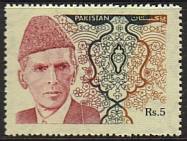
 Unlike India, the distinction between regular stamps and commemorative stamps was not clear in Pakistan in the beginning. Since the 1948 issue, a set of medium size stamps were issued on the Independence Day (14 August) or on Pakistan Day (23 March) and used as regular stamps.
Unlike India, the distinction between regular stamps and commemorative stamps was not clear in Pakistan in the beginning. Since the 1948 issue, a set of medium size stamps were issued on the Independence Day (14 August) or on Pakistan Day (23 March) and used as regular stamps.
Recent stamps that are regularly available at post offices depict the father of the nation Mr. Muhammad Ali Jinnah (see the photo on the left). Low denominations have Islamic designs (the photo on the right). High denominations are often commemorative stamps.
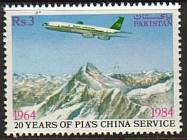
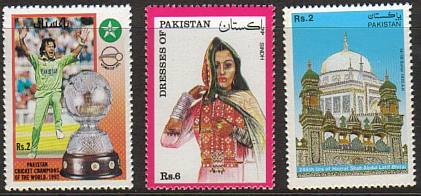 The first charm of Pakistani stamps is its variety of themes found on commemorative stamps. In large post office in Pakistan, it is worthwhile to search a philatelic bureau window. You can buy various commemorative stamps at face values. You can find Himalayan mountains, endangered wildlife, cricket heroes, historic buildings, folk costumes, and so on. The Pakistan Post Office has a sound policy of limiting the motives of stamps to those with relevance to Pakistan.
The first charm of Pakistani stamps is its variety of themes found on commemorative stamps. In large post office in Pakistan, it is worthwhile to search a philatelic bureau window. You can buy various commemorative stamps at face values. You can find Himalayan mountains, endangered wildlife, cricket heroes, historic buildings, folk costumes, and so on. The Pakistan Post Office has a sound policy of limiting the motives of stamps to those with relevance to Pakistan.
According to the Scott postage catalogue, about 750 stamps were issued between 1947 and 1990. Except for the high values of 1947 overprinted issues, no stamp has a big premium so that it is feasible to have a complete collection of postage stamps of Pakistan. If you buy Pakistan stamps in bulk, you will find a number of stamps inscribed "SERVICE". They are called official stamps and issued for the postal payment by government agencies.

3. Errors and Varieties
The second charm of Pakistani stamps is its richness of errors and manufacturing varieties. The first stamps of Pakistan were overprinted ones so that there exists a rare variety of "inverted" overprints.

When the currency was changed into a decimal system in 1961, there was a short supply of stamps denominated in the new currency. Therefore, the Pakistan Security Press, a few local printers, and numerous local post offices surcharged new denominations on the stock of old stamps. Errors and varieties found from the surcharges by the Pakistan Security Press are indeed rare. In contrast, errors and varieties found from the surcharges by the local printers are not so rare. The photo on the left is such an example: the first left stamp is the ordinary one with "7 PAISA" surcharged; the second one is an error with "7 PIASA"; the third one does not have number 7! ("AISA"); and the first right stamps is surcharged inverse. They are indeed big errors, but not rare at all. In other words, it is such a fun to have big errors in my collection paying only a little premium over the ordinary stamps.
 Another type of errors and varieties is with respect to perforations. Imperforate varieties are found for most issues of regular stamps. The photo on the right is such an example. The 2 rupee stamps show the Mausoleum of Ibrahim Khan issued in 1979 but without perforation. Here again, the imperforate stamps are not so rare, indicating the poor quality control of the Pakistan Security Press. It is not advised to pay big money for these varieties.
Another type of errors and varieties is with respect to perforations. Imperforate varieties are found for most issues of regular stamps. The photo on the right is such an example. The 2 rupee stamps show the Mausoleum of Ibrahim Khan issued in 1979 but without perforation. Here again, the imperforate stamps are not so rare, indicating the poor quality control of the Pakistan Security Press. It is not advised to pay big money for these varieties.
Varieties in watermarks are also interesting. In Pakistan, watermarked papers are still in use. The direction of the moon is sometimes reversed. You can see the watermark on the imperforate 2 rupee stamps. If the moon is facing upward, the paper was reversed wrongly in the printing process.
 Even among commemorative stamps, we can find many interesting varieties in Pakistan. For example, die flaws are reported for various issues. The photo on the left shows the commemorative stamps issued in 1968 on WHO. The left stamp is an ordinary one with "15 PAISA"; the right stamp shows "15 PAIS". You can find one stamp with this variety in every sheet.
Even among commemorative stamps, we can find many interesting varieties in Pakistan. For example, die flaws are reported for various issues. The photo on the left shows the commemorative stamps issued in 1968 on WHO. The left stamp is an ordinary one with "15 PAISA"; the right stamp shows "15 PAIS". You can find one stamp with this variety in every sheet.

4. Historical Context
The third charm of Pakistani philately comes from interesting materials from a viewpoint of postal history. First,Pakistan stamps were not only used in areas currently in Pakistan. Until 1971, they were also used in East Pakistan. Therefore, you can find on Pakistan stamps the names of post offices currently in Bangladesh.
 When the British India was partitioned into India and Pakistan on August 1947, British Indian post offices in Dubai and Muscat were inherited by Pakistan and managed by Karachi GPO. These Pakistani post offices were closed on 1 April 1948. This chronology implies that "PAKISTAN" overprinted stamps were used in Dubai and Muscat only for 6 months from 1 Oct 1947 to 31 March 1948. The photo on the left shows an example of this usage. The PAKISTAN overprinted stamps were cancelled in Dubai on 27 Jan. 1948 and sent to Bombay.
When the British India was partitioned into India and Pakistan on August 1947, British Indian post offices in Dubai and Muscat were inherited by Pakistan and managed by Karachi GPO. These Pakistani post offices were closed on 1 April 1948. This chronology implies that "PAKISTAN" overprinted stamps were used in Dubai and Muscat only for 6 months from 1 Oct 1947 to 31 March 1948. The photo on the left shows an example of this usage. The PAKISTAN overprinted stamps were cancelled in Dubai on 27 Jan. 1948 and sent to Bombay.
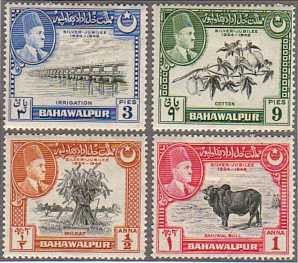 Second, the princely state of Bahawalpur, which lies in the southern part of Punjab, issued local stamps during the period 1947-49. They were valid only in Bahawalpur. The photo on the right shows a set of four stamps issued in 1949. These stamps were beautifully engraved and shows industrial symbols of Bahawalpur: irrigation barrage, wheat, cotton, and local bullock. About 60 Bahawalpur stamps were issued and all of them are in high quality, reflecting the hobby of the state's ruler (he himself was an enthusiastic philatelist).
Second, the princely state of Bahawalpur, which lies in the southern part of Punjab, issued local stamps during the period 1947-49. They were valid only in Bahawalpur. The photo on the right shows a set of four stamps issued in 1949. These stamps were beautifully engraved and shows industrial symbols of Bahawalpur: irrigation barrage, wheat, cotton, and local bullock. About 60 Bahawalpur stamps were issued and all of them are in high quality, reflecting the hobby of the state's ruler (he himself was an enthusiastic philatelist).
 Third, the period of the Bangladesh's Independence War is particularly interesting with various materials. As an emergency step during the war, the Government of Pakistan began postal censorship on civilian mails. Several mails were disrupted due to the war. Pakistani stamps were used temporarily in Bangladesh after its independence with overprints. The war left more than one lakh (100,000) prisoners of war (POW) in India and Pakistan. The photo shown on the left is an example of POW mail. The envelope was sent on November 1072 from NWFP, Pakistan, addressed to the POW #224870, detained in a camp in India. The POW's family in NWFP put 20 paise stamp for postage (inland mail rate) and the letter was sent to the POW through the International Red Cross (IRC), Lahore, Pakistan.
Third, the period of the Bangladesh's Independence War is particularly interesting with various materials. As an emergency step during the war, the Government of Pakistan began postal censorship on civilian mails. Several mails were disrupted due to the war. Pakistani stamps were used temporarily in Bangladesh after its independence with overprints. The war left more than one lakh (100,000) prisoners of war (POW) in India and Pakistan. The photo shown on the left is an example of POW mail. The envelope was sent on November 1072 from NWFP, Pakistan, addressed to the POW #224870, detained in a camp in India. The POW's family in NWFP put 20 paise stamp for postage (inland mail rate) and the letter was sent to the POW through the International Red Cross (IRC), Lahore, Pakistan.

5. Toward Intermediate and Advanced Collecting
Even the beginner collector needs a catalogue. The world-wide catalogues issued by Scott in USA and by Stanley Gibbons in UK may be convenient for general collectors. Both of them are not detailed enough for intermediate collectors, however. From Pakistan, there are several catalogues available that are more detailed than Scott or Gibbons. My recommendation is the color catalogue edited and published by Mr. M.I. Choudhary of Lahore. Its latest version (2004-05 version) includes concise explanations on various topics that are important for serious collectors of Pakistan stamps.
Varieties in overprints and surcharges are briefly discussed in Choudhary's book. If you need more information on the 1947-49 issues of "PAKISTAN" overprints, there are several good references. The classic is: D.R. Martin, Pakistan Overprints on Indian Stamps 1948-49, London: Robson Lowe, 1959 (there are Pakistani reprints as well). Based on Martin's research, the most comprehensive reference book is: Ron Doubleday & Usman Ali Isani, Pakistan Overprints on Indian Stamps and Postal Stationery 1947-1949, Karachi, 1993. This book of 820 pages not only covers detailed information on overprinting types but also useful as a reference to understand the postal history during the period.
On the 1961 decimal currency surcharges, the following book is a must: U.A. Isani, Stamps of Pakistan (Decimal Currency Surcharges), Karachi, 1981.
For serious collectors of Pakistan stamps, becoming a member of two UK-based associations could be worthwhile. The India Study Circle for Philately is a research association with established authority. Its quarterly India Post (since 1950s) sometimes publishes important articles related with Pakistan. More recently, the Pakistan Study Circle has been established in UK and publishes high quality newsletters.
Back to Tak's Philately, Main Page



 It is not so obvious which stamp is the first issue of Pakistan. The modern postal system in South Asia began in 1854 when the East India Company issued postage stamps. Before this issue, a local postage stamp was issued in 1852, known as "Scinde Dak". Scinde Dak is the oldest stamp in Asia and was used in Karachi City and remaining Sind regions. Since Karachi and Sind are part of Pakistan today, it is possible to claim that Scinde Dak is the first stamp of Pakistan. Unfortunately, I do not have this rarity stamp. Therefore, I show stamps of Pakistan (left) and India (right) depicting Scinde Dak.
It is not so obvious which stamp is the first issue of Pakistan. The modern postal system in South Asia began in 1854 when the East India Company issued postage stamps. Before this issue, a local postage stamp was issued in 1852, known as "Scinde Dak". Scinde Dak is the oldest stamp in Asia and was used in Karachi City and remaining Sind regions. Since Karachi and Sind are part of Pakistan today, it is possible to claim that Scinde Dak is the first stamp of Pakistan. Unfortunately, I do not have this rarity stamp. Therefore, I show stamps of Pakistan (left) and India (right) depicting Scinde Dak.
 Therefore, the first stamp of Pakistan, according to the orthodox classification among philatelists, is a set of British Indian stamps overprinted "PAKISTAN" (see the photo on the left). Because of the turmoil due to the Partition of British India, the new state of Pakistan could not afford a commemorative stamp. One and a half months later, on 1 October 1947, new stamps of Pakistan were issued, which were British Indian stamps overprinted "PAKISTAN" by India's Printing Authority at Nasik. Pakistani people had to wait until July 1948 to have a set of new stamps printed for Pakistan. The photo on the right shows an 1 Re stamp from this set. This stamps is beautifully engraved with Urdu inscription reading "Long Live Pakistan." I would like to give to this issue the title of the first stamp of Pakistan.
Therefore, the first stamp of Pakistan, according to the orthodox classification among philatelists, is a set of British Indian stamps overprinted "PAKISTAN" (see the photo on the left). Because of the turmoil due to the Partition of British India, the new state of Pakistan could not afford a commemorative stamp. One and a half months later, on 1 October 1947, new stamps of Pakistan were issued, which were British Indian stamps overprinted "PAKISTAN" by India's Printing Authority at Nasik. Pakistani people had to wait until July 1948 to have a set of new stamps printed for Pakistan. The photo on the right shows an 1 Re stamp from this set. This stamps is beautifully engraved with Urdu inscription reading "Long Live Pakistan." I would like to give to this issue the title of the first stamp of Pakistan.

 Unlike India, the distinction between regular stamps and commemorative stamps was not clear in Pakistan in the beginning. Since the 1948 issue, a set of medium size stamps were issued on the Independence Day (14 August) or on Pakistan Day (23 March) and used as regular stamps.
Unlike India, the distinction between regular stamps and commemorative stamps was not clear in Pakistan in the beginning. Since the 1948 issue, a set of medium size stamps were issued on the Independence Day (14 August) or on Pakistan Day (23 March) and used as regular stamps. 
 The first charm of Pakistani stamps is its variety of themes found on commemorative stamps. In large post office in Pakistan, it is worthwhile to search a philatelic bureau window. You can buy various commemorative stamps at face values. You can find Himalayan mountains, endangered wildlife, cricket heroes, historic buildings, folk costumes, and so on. The Pakistan Post Office has a sound policy of limiting the motives of stamps to those with relevance to Pakistan.
The first charm of Pakistani stamps is its variety of themes found on commemorative stamps. In large post office in Pakistan, it is worthwhile to search a philatelic bureau window. You can buy various commemorative stamps at face values. You can find Himalayan mountains, endangered wildlife, cricket heroes, historic buildings, folk costumes, and so on. The Pakistan Post Office has a sound policy of limiting the motives of stamps to those with relevance to Pakistan. 

 Another type of errors and varieties is with respect to perforations. Imperforate varieties are found for most issues of regular stamps. The photo on the right is such an example. The 2 rupee stamps show the Mausoleum of Ibrahim Khan issued in 1979 but without perforation. Here again, the imperforate stamps are not so rare, indicating the poor quality control of the Pakistan Security Press. It is not advised to pay big money for these varieties.
Another type of errors and varieties is with respect to perforations. Imperforate varieties are found for most issues of regular stamps. The photo on the right is such an example. The 2 rupee stamps show the Mausoleum of Ibrahim Khan issued in 1979 but without perforation. Here again, the imperforate stamps are not so rare, indicating the poor quality control of the Pakistan Security Press. It is not advised to pay big money for these varieties. Even among commemorative stamps, we can find many interesting varieties in Pakistan. For example, die flaws are reported for various issues. The photo on the left shows the commemorative stamps issued in 1968 on WHO. The left stamp is an ordinary one with "15 PAISA"; the right stamp shows "15 PAIS". You can find one stamp with this variety in every sheet.
Even among commemorative stamps, we can find many interesting varieties in Pakistan. For example, die flaws are reported for various issues. The photo on the left shows the commemorative stamps issued in 1968 on WHO. The left stamp is an ordinary one with "15 PAISA"; the right stamp shows "15 PAIS". You can find one stamp with this variety in every sheet.
 When the British India was partitioned into India and Pakistan on August 1947, British Indian post offices in Dubai and Muscat were inherited by Pakistan and managed by Karachi GPO. These Pakistani post offices were closed on 1 April 1948. This chronology implies that "PAKISTAN" overprinted stamps were used in Dubai and Muscat only for 6 months from 1 Oct 1947 to 31 March 1948. The photo on the left shows an example of this usage. The PAKISTAN overprinted stamps were cancelled in Dubai on 27 Jan. 1948 and sent to Bombay.
When the British India was partitioned into India and Pakistan on August 1947, British Indian post offices in Dubai and Muscat were inherited by Pakistan and managed by Karachi GPO. These Pakistani post offices were closed on 1 April 1948. This chronology implies that "PAKISTAN" overprinted stamps were used in Dubai and Muscat only for 6 months from 1 Oct 1947 to 31 March 1948. The photo on the left shows an example of this usage. The PAKISTAN overprinted stamps were cancelled in Dubai on 27 Jan. 1948 and sent to Bombay. Second, the princely state of Bahawalpur, which lies in the southern part of Punjab, issued local stamps during the period 1947-49. They were valid only in Bahawalpur. The photo on the right shows a set of four stamps issued in 1949. These stamps were beautifully engraved and shows industrial symbols of Bahawalpur: irrigation barrage, wheat, cotton, and local bullock. About 60 Bahawalpur stamps were issued and all of them are in high quality, reflecting the hobby of the state's ruler (he himself was an enthusiastic philatelist).
Second, the princely state of Bahawalpur, which lies in the southern part of Punjab, issued local stamps during the period 1947-49. They were valid only in Bahawalpur. The photo on the right shows a set of four stamps issued in 1949. These stamps were beautifully engraved and shows industrial symbols of Bahawalpur: irrigation barrage, wheat, cotton, and local bullock. About 60 Bahawalpur stamps were issued and all of them are in high quality, reflecting the hobby of the state's ruler (he himself was an enthusiastic philatelist). Third, the period of the Bangladesh's Independence War is particularly interesting with various materials. As an emergency step during the war, the Government of Pakistan began postal censorship on civilian mails. Several mails were disrupted due to the war. Pakistani stamps were used temporarily in Bangladesh after its independence with overprints. The war left more than one lakh (100,000) prisoners of war (POW) in India and Pakistan. The photo shown on the left is an example of POW mail. The envelope was sent on November 1072 from NWFP, Pakistan, addressed to the POW #224870, detained in a camp in India. The POW's family in NWFP put 20 paise stamp for postage (inland mail rate) and the letter was sent to the POW through the International Red Cross (IRC), Lahore, Pakistan.
Third, the period of the Bangladesh's Independence War is particularly interesting with various materials. As an emergency step during the war, the Government of Pakistan began postal censorship on civilian mails. Several mails were disrupted due to the war. Pakistani stamps were used temporarily in Bangladesh after its independence with overprints. The war left more than one lakh (100,000) prisoners of war (POW) in India and Pakistan. The photo shown on the left is an example of POW mail. The envelope was sent on November 1072 from NWFP, Pakistan, addressed to the POW #224870, detained in a camp in India. The POW's family in NWFP put 20 paise stamp for postage (inland mail rate) and the letter was sent to the POW through the International Red Cross (IRC), Lahore, Pakistan.